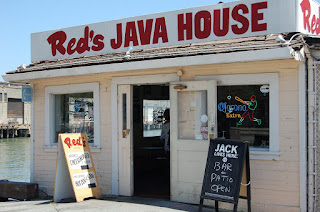
My hometown of Pacifica has gotten on foodie radar because of Gorilla Barbecue, a tiny joint on Highway 1 about a half hour drive south of San Francisco. People line up even before Gorilla opens Wednesdays through Mondays at noon for pork ribs, beef brisket, pulled pork, chicken and hot links cooked up in a wood-fired smoker in an old bright-orange rail car.
I'm not a huge barbecue fan but I love this version. Rich Bacchi (in photo) calls it Texa-lina, a mix of Texas and Carolina barbecue. The meat is smoked Texas style but the sauce is Carolina variety, meaning vinegary, not heavy and sweet.
Bacchi and his partner Jeff Greathouse, like me Pacifica natives and Terra Nova High grads (go Tigers!), pack 36 racks of ribs a day in the smoker, but it's not nearly enough.
The spot has attracted a lot of attention in barbecue circles since it opened two years ago. The Food Network's Guy Fieri of the show Diners, Drive-Ins and Dives showcased the place and the big personalities of the two owners a couple of months ago. The episode is scheduled for rebroadcast this coming weekend (check listings). Bacchi said Fieri's followers have driven and even flown in from all parts of the country to check out the food here. Make sure you get to Gorilla early, though. On weekends, they typically sell out of ribs by 4:30 p.m. and on weekdays well before their 8 p.m. closing time. One way to tell is to check out the chimney. "If it's smokin', we're open" is Gorilla's slogan.

Bacchi is hoping to remedy the shortage by adding a second smoker sometime in the next few months. A warning: there's no place to eat at Gorilla, except for a couple of picnic tables set in the often chilly, fog-shrouded hillside above the rail car. You'll see lots of people sitting in the cabs of their trucks in the parking lot outside, or hurrying home with bags of mouth-watering barbecue.
.jpg)





